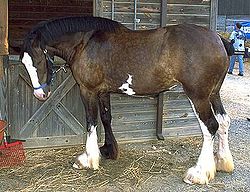 Clydesdales are noted for grace and versatility; they stand on average between 16 to 17 hands (64 to 68 inches, 163 to 173 cm) (the current world-record holding Clydesdale is 20 hands (80 inches, 203 cm)) in height and can weigh upwards of one short ton 2,000 pounds (910 kg). A Clydesdale has an elegant head with a straight profile (a convex profile is frowned upon), small ears, large, dark eyes, and a heavy forelock. The neck is long and slightly arched, the chest deep, and the shoulders are well sloped and muscular. The action is energetic and ground covering. The Clydesdale tends to exhibit a longer coupling than its cousin, the Shire, and the withers are clearly defined. The hindquarters are well-muscled and have a distinctively rounded silhouette. The legs should be long and strong with characteristically large hoof size, typically at least twice the diameter of those of a light riding horse, such as a Thoroughbred. The pasterns are longer and sloping than those of a stock-type horse. Perhaps the most widely recognised feature of the Clydesdale's appearance is the abundance of feather, the long hairs that fall from just below the knees and hocks to cover the hooves.
Clydesdales are noted for grace and versatility; they stand on average between 16 to 17 hands (64 to 68 inches, 163 to 173 cm) (the current world-record holding Clydesdale is 20 hands (80 inches, 203 cm)) in height and can weigh upwards of one short ton 2,000 pounds (910 kg). A Clydesdale has an elegant head with a straight profile (a convex profile is frowned upon), small ears, large, dark eyes, and a heavy forelock. The neck is long and slightly arched, the chest deep, and the shoulders are well sloped and muscular. The action is energetic and ground covering. The Clydesdale tends to exhibit a longer coupling than its cousin, the Shire, and the withers are clearly defined. The hindquarters are well-muscled and have a distinctively rounded silhouette. The legs should be long and strong with characteristically large hoof size, typically at least twice the diameter of those of a light riding horse, such as a Thoroughbred. The pasterns are longer and sloping than those of a stock-type horse. Perhaps the most widely recognised feature of the Clydesdale's appearance is the abundance of feather, the long hairs that fall from just below the knees and hocks to cover the hooves.
The characteristic action of a Clydesdale is demonstrated at a trot, which is an animated gait with high hoof action in both the front and rear. Despite its large size, the Clydesdale presents with an energetic quality described by the Clydesdale Horse Society as "gaiety of carriage and outlook."
